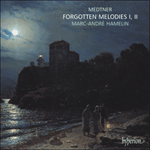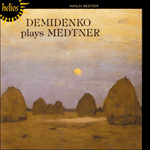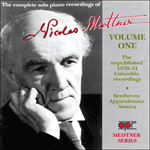
Welcome to Hyperion Records, an independent British classical label devoted to presenting high-quality recordings of music of all styles and from all periods from the twelfth century to the twenty-first.
Hyperion offers both CDs, and downloads in a number of formats. The site is also available in several languages.
Please use the dropdown buttons to set your preferred options, or use the checkbox to accept the defaults.

There are hints that Canzona matinata (‘Morning song’), carefree in its outer sections but melancholy in the middle, depicts the morn of life, youth, with its generally sunny but occasionally black moods, in contrast to the struggles and tragedies of later life. The latter theme is implicit in the final work of the cycle, the Sonata tragica, which the composer always insisted should be preceded by a performance of the Canzona matinata. A remarkable intensity of emotion is concentrated in its single movement. Typically for Medtner, the two apparently contrasting main themes, the first tragic and launched by what sounds like a blow of fate, the second consolatory, prove to be one and the same in different guises. In the development there is an almost literal restatement of the sombre central theme from the Canzona matinata but there is little relief. Tension mounts in the recapitulation, and the work moves inexorably towards a devastating coda, which concludes with the blow of fate with which the sonata began.
from notes by Barrie Martyn © 1998
La Canzona matinata («Chanson matinale»), insouciante dans ses sections extrêmes mais déprimée dans sa section centrale, suggère une peinture du matin de la vie, de la jeunesse, avec ses humeurs généralement ensoleillées mais parfois sombres, par opposition aux luttes et tragédies ultérieures. Ce dernier thème est implicite dans l’œuvre finale du cycle, la Sonata tragica (Medtner insistait toujours pour qu’elle fût précédée d’une exécution de la Canzona matinata), dont le mouvement unique présente une remarquable concentration d’intensité émotionnelle. Fait typique du compositeur, les deux thèmes principaux apparemment contrastés—le premier, tragique et lancé par ce qui ressemble à un coup du sort, l’autre, consolant—se révèlent un seul et même thème sous des dehors différents. Le développement comporte une réénonciation quasi littérale du sombre thème central de la Canzona matinata, mais l’apaisement est peu présent. La tension monte à la reprise et l’œuvre se meut inexorablement vers une coda dévastatrice, qui conclut la sonate sur le coup du sort par lequel elle avait commencé.
extrait des notes rédigées par Barrie Martyn © 1998
Français: Hypérion
Es gibt Anzeichen, daß die Canzona matinata („Morgenlied“), die sorglos in den äußeren Abschnitten jedoch melancholisch in der Mitte ist, den Frühling des Lebens, der im großen und ganzen sonnig ist, aber gelegentlich düstere Stimmungen aufweist, im Gegensatz zu dem Sichmühen und den tragischen Ereignissen im späteren Leben darstellt. Letzteres Thema ist im letzten Werk des Zyklus, der Sonata tragica, bei der der Komponist stets darauf bestand, daß sie nach der Canzona matinata aufgeführt werden sollte, implizit. Eine bemerkenswerte Gefühlsintensität ist in ihrem einzigen Satz konzentriert. Wie es für Medtner typisch ist, stellt sich heraus, daß die zwei scheinbar kontrastierenden Hauptthemen, von denen das erste tragisch ist und das mit etwas beginnt, das wie ein Schicksalsschlag klingt, und das andere tröstend ist, ein und das gleiche in unterschiedlicher Gestalt sind. In der Durchführung ist eine fast wörtliche Wiederholung des schwermütigen zentralen Themas aus der Canzona matinata enthalten, doch es folgt nur wenig Erleichterung. Die Spannung steigt in der Reprise, und das Werk bewegt sich unweigerlich auf eine niederschmetternde Koda zu, die mit dem Schicksalsschlag endet, mit dem die Sonate begann.
aus dem Begleittext von Barrie Martyn © 1998
Deutsch: Anke Vogelhuber
 Medtner: Forgotten Melodies Medtner: Forgotten Melodies‘I can only agree with the superlatives Hamelin has garnered from so many other reviewers. His technique is unsurpassed by any pianist of any era ... ‘Hamelin's transcendental technique is breathtaking in the bravura numbers, and he is even more compelling in the reflective numbers, such as Two Tale ...» More |
 Medtner: The complete solo piano recordings, Vol. 3 Medtner: The complete solo piano recordings, Vol. 3'The clarity and subtlety of Medtner’s playing is as captivating here as in the previous volumes … Medtner piles on the colouristic dimensions to ...» More |
 Medtner: Demidenko plays Medtner Medtner: Demidenko plays Medtner‘Few can touch this stunning Demidenko programme, excellently recorded and featuring playing of the highest order’ (BBC Music Magazine Top 1000 CDs Guide) ‘I must be careful not to make this sound like an indiscriminate rave review, but what do you do when a disc of this calibre drops through your letter ...» More |
 Medtner: The complete solo piano recordings, Vol. 1 Medtner: The complete solo piano recordings, Vol. 1'In short this is an issue of the highest conceivable importance … APR’s documentation is superb in every way. The transfers, of copies many of w ...» More |

